Welcome to Nakomart.com, your source for in-depth reviews. In this guide, we’re focusing on smart thermostats, which can change how you control your home’s climate. Whether you’re tech-savvy or just starting to explore smart home technologies, understanding how a smart thermostat can change your daily life is important. Let’s look at why these devices are important for modern homes. We’ll explain what they do, why they’re useful, and how they fit into your life. Stay tuned as we help you choose the best smart thermostat for comfort and efficiency.
Welcome to Nakomart.com, your source for in-depth reviews. In this guide, we’re focusing on smart thermostats, which can change how you control your home’s climate. Whether you’re tech-savvy or just starting to explore smart home technologies, understanding how a smart thermostat can change your daily life is important. Let’s look at why these devices are important for modern homes. We’ll explain what they do, why they’re useful, and how they fit into your life. Stay tuned as we help you choose the best smart thermostat for comfort and efficiency.

Unlike conventional models, smart thermostats can learn from your behavior and adjust settings to suit your schedule and preferences, often without requiring manual inputs after initial setup.

With a smart thermostat, you can control your home’s climate from anywhere in the world. Using a compatible smartphone app, adjust temperatures, set schedules, and monitor your home’s energy use on the go.

These devices can seamlessly integrate with other smart home technology, providing a holistic approach to home automation. Control lights, locks, and your thermostat with a single command.

Gain insights into your energy consumption with detailed reports. Smart thermostats can also send alerts for unusual patterns, like a sudden temperature drop, which might indicate a heating system issue.

Some models use your phone’s location to adjust your home’s temperature based on how near or far you are from your house.

Compatible with voice assistants like Alexa, Google Assistant, and Siri, allowing for hands-free operation.

They can remind you when to change air filters or schedule regular maintenance, helping extend the life of your HVAC system.
Smart thermostats represent a fusion of technology and practicality, designed not just to add convenience but to transform how you interact with your home environment, making it smarter, more responsive, and energy-efficient.
Selecting the ideal smart thermostat for your home involves understanding both your specific needs and the unique features offered by different models. Here’s a step-by-step guide to help you find a thermostat that not only meets your requirements but also enhances your home’s energy management and comfort.

Check System Type: Ensure the smart thermostat you consider is compatible with your existing heating, ventilation, and air conditioning (HVAC) system. Most smart thermostats are compatible with common systems, but some may require additional hardware or have limitations with certain setups like high-voltage systems or those with unusual wiring.
Multi-Zone Systems: If your home has multiple heating or cooling zones, you’ll need a thermostat that can manage multiple zones independently.
Learning Ability: Decide if you want a thermostat that learns your schedule and adjusts automatically, like the Nest, or one that requires manual schedule setting.
Remote Access and Controls: Consider how important it is for you to control your thermostat remotely via a mobile app. This feature is essential for adjusting your home’s temperature on the go.
Integration Capabilities: If you have other smart devices or plan to purchase them, look for a thermostat that integrates well with the rest of your smart home ecosystem.
Sensors: Some smart thermostats come with additional sensors for better accuracy and efficiency. These can detect room occupancy or even the temperature in different rooms, adjusting the heating or cooling based on where you are in the home.
User Interface: The thermostat should have an intuitive interface. Look at reviews or try out the interface yourself to ensure you find it easy to use.
App Reviews: Since you’ll often use a smartphone app to interact with the thermostat, reading reviews of the app can provide insights into its reliability and user-friendliness.
Initial Cost vs. Long-Term Savings: Smart thermostats can be an investment. While some high-end models come with a steeper price tag, they often offer more features and greater energy savings. Determine your budget and consider if a higher upfront cost could be offset by long-term reductions in energy bills.
Rebates and Incentives: Look for rebates or incentives from local governments or utility providers that can reduce the cost of a smart thermostat.
Warranty Duration and Coverage: A longer warranty can provide peace of mind. Check what aspects of the thermostat are covered under warranty, including software and hardware.
Customer Support: Reliable customer support is crucial. Ensure the brand offers comprehensive support through multiple channels like phone, email, or live chat.
By following these steps, you’ll be well-equipped to choose a smart thermostat that aligns with your lifestyle and enhances your home’s energy efficiency. Remember, the right thermostat can do more than just adjust your home’s temperature; it can also learn your habits and even save you money.
When it comes to choosing a smart thermostat, the market is filled with a variety of options. Here we review seven top-rated smart thermostats, highlighting their pros, cons, and distinctive features to help you make an informed decision:
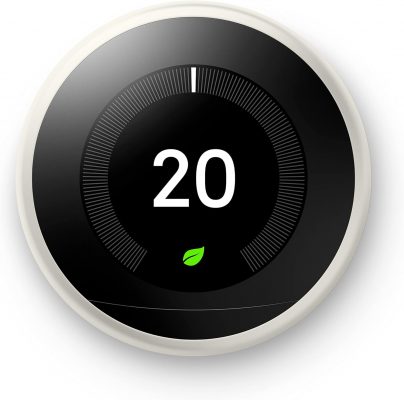
The Nest Learning Thermostat (3rd Generation) is an advanced device designed for those who appreciate technology’s role in enhancing home management and energy efficiency. Its ability to learn and adapt to your daily schedule sets it apart from traditional thermostats, effectively reducing the need for manual controls and offering a truly automated experience. The thermostat adjusts the heating and cooling based on your habits and preferences, which not only enhances comfort but also ensures optimal energy use.
Beyond its smart capabilities, the Nest’s design is sleek and modern, featuring a high-quality glass face and stainless steel ring that complements a wide range of interior styles. The Farsight feature is particularly impressive, as it allows the display to light up when it senses you in the room, showing the current temperature or time in a large, clear format.
While the price is on the higher end, the investment can pay off through significant energy savings. The thermostat tracks your energy usage in daily and monthly reports, allowing you to see exactly how much you’re saving and helping to make cost-effective adjustments. Installation is straightforward for those with newer systems, but some might require an electrician to handle older wiring or the absence of a C-wire.
Overall, the Nest Learning Thermostat (3rd Generation) is ideal for tech-savvy users looking for a mix of style, functionality, and proactive energy management. Its comprehensive features not only make daily life more convenient but also contribute to a more environmentally friendly home.

The Nest Learning Thermostat (3rd Generation) is an advanced device designed for those who appreciate technology’s role in enhancing home management and energy efficiency. Its ability to learn and adapt to your daily schedule sets it apart from traditional thermostats, effectively reducing the need for manual controls and offering a truly automated experience. The thermostat adjusts the heating and cooling based on your habits and preferences, which not only enhances comfort but also ensures optimal energy use.
Beyond its smart capabilities, the Nest’s design is sleek and modern, featuring a high-quality glass face and stainless steel ring that complements a wide range of interior styles. The Farsight feature is particularly impressive, as it allows the display to light up when it senses you in the room, showing the current temperature or time in a large, clear format.
While the price is on the higher end, the investment can pay off through significant energy savings. The thermostat tracks your energy usage in daily and monthly reports, allowing you to see exactly how much you’re saving and helping to make cost-effective adjustments. Installation is straightforward for those with newer systems, but some might require an electrician to handle older wiring or the absence of a C-wire.
Overall, the Nest Learning Thermostat (3rd Generation) is ideal for tech-savvy users looking for a mix of style, functionality, and proactive energy management. Its comprehensive features not only make daily life more convenient but also contribute to a more environmentally friendly home.
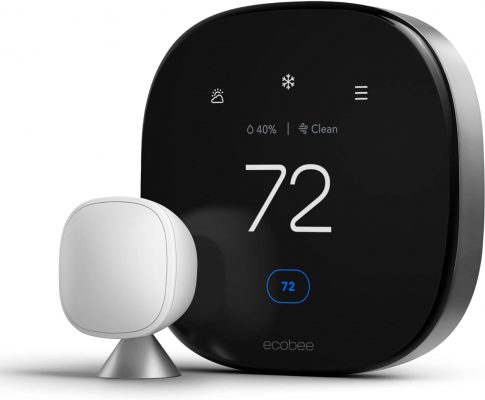
The Ecobee SmartThermostat with Voice Control stands out in the realm of smart home devices due to its robust integration of Alexa and its sophisticated remote sensor system. This thermostat goes beyond simple temperature adjustments; it acts as a hub for controlling various aspects of your home environment and smart home devices. With Alexa built-in, it can respond to voice commands not only for temperature control but also for other smart home tasks like adjusting lights or checking the news.
The inclusion of remote sensors is a significant advantage of this model. These sensors detect both temperature and room occupancy, which means the system can manage the climate based on actual usage patterns of different rooms. This feature is particularly beneficial for homes with uneven temperature distributions or for families that spend most of their time in specific areas of the house.
Another high point is the Ecobee’s intuitive touchscreen interface. The screen is bright and easy to navigate, making it accessible even for users who are not tech-savvy. The device also offers detailed energy consumption reports, which are not only informative but can help users make proactive adjustments to save on their energy bills.
On the downside, the Ecobee’s installation might be a bit daunting for those who aren’t familiar with HVAC systems, especially in homes that lack a C-wire. While the thermostat comes with an adapter to work around this issue, the setup could still require professional installation, adding to the overall cost. Additionally, the price point of the Ecobee is higher than some of its competitors, but for those who value advanced features and integration capabilities, the investment can be well worth it.
In conclusion, the Ecobee SmartThermostat with Voice Control is an excellent choice for tech enthusiasts and those invested in creating a comprehensive smart home ecosystem. It combines convenience, efficiency, and control, offering a futuristic approach to home climate management. The thermostat not only learns and adapts to your lifestyle but also interacts seamlessly with other devices, elevating the smart home experience.
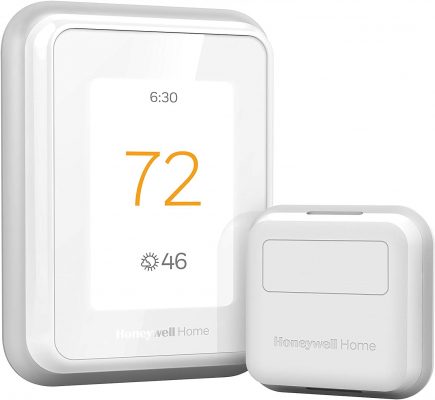
The Honeywell Home T9 Smart Thermostat provides an excellent balance between functionality and cost-effectiveness, making it an appealing choice for those looking to upgrade to a smart thermostat without a substantial investment. One of the standout features of the T9 is its smart room sensors. These sensors go beyond basic temperature readings; they also assess humidity levels, ensuring that each room is conditioned to provide maximum comfort. This is particularly advantageous for homes where certain areas tend to be hotter or colder than others.
Despite its lower price point, the T9 doesn’t skimp on essential smart features. It offers flexible scheduling and some degree of adaptive learning, understanding your home’s heating and cooling needs over time. However, it’s important to note that the T9’s learning capabilities aren’t as developed as those in more expensive models like the Nest or Ecobee, which might be a consideration for those seeking a more ‘set it and forget it’ type of thermostat.
Installation of the T9 is straightforward, with clear instructions and support available, making it a great choice for DIY enthusiasts. The interface, both on the device itself and in the accompanying app, is intuitive, ensuring that users of all tech levels can manage their home climate controls without confusion.
However, the T9’s design is quite basic and functional. It lacks the high-end aesthetic appeal of some of its competitors, which might be a drawback for users who prioritize the look of their home gadgets as much as their functionality.
Overall, the Honeywell Home T9 Smart Thermostat is recommended for those who need reliable, room-specific temperature control without the frills of more advanced AI learning or a high-fashion design. It strikes a good balance between price and performance, offering essential smart thermostat functionalities and remote sensor integration at a reasonable cost. This makes the T9 a practical choice for budget-conscious consumers looking to step into smart home technology.
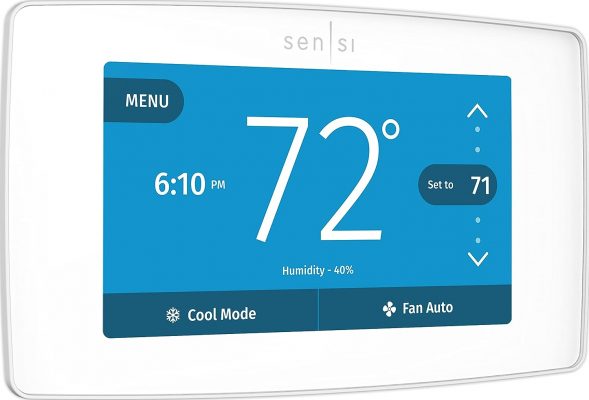
The Emerson Sensi Touch WiFi Smart Thermostat is a standout option for those who are entering the smart thermostat market but may be hesitant to invest in the more expensive models. One of its most appealing features is its affordability coupled with essential smart functionalities, making smart home technology more accessible to a wider audience.
The large, color touchscreen of the Sensi Touch is user-friendly, with clear menus and easy navigation that make setup and daily use straightforward. This is ideal for those who may not be tech-savvy but still want the convenience of a smart thermostat. The app that accompanies the thermostat is also well-designed, providing a seamless experience from installation to daily adjustments.
Smart alerts are another benefit of the Sensi Touch, offering homeowners peace of mind by monitoring their system’s performance and environmental conditions. These alerts ensure that users are informed of extreme conditions that could affect their comfort or signal potential HVAC issues, and maintenance reminders help keep the system running efficiently.
However, where the Sensi Touch falls short is in its learning capabilities. Unlike some of its pricier counterparts, it does not learn and adapt to user habits automatically. Users need to manually set schedules and make adjustments over time, which might be a drawback for those looking for a more “hands-off” approach. Additionally, the thermostat does not provide as detailed energy usage analytics as some other models, which can be a valuable tool for those looking to reduce their energy costs further.
In terms of design, the Sensi Touch is functional but lacks the aesthetic refinement of higher-end models like the Nest or Ecobee. This may be a consideration for users who are looking for a device that complements their home’s interior design.
In conclusion, the Emerson Sensi Touch WiFi Smart Thermostat is an excellent choice for budget-conscious consumers or first-time smart thermostat users. It offers the necessary features to significantly enhance home climate control and ease of use, all at a price point that is hard to beat. While it may not have the advanced learning technology of more expensive models, its value is exceptional, providing dependable performance and essential smart features without breaking the bank.
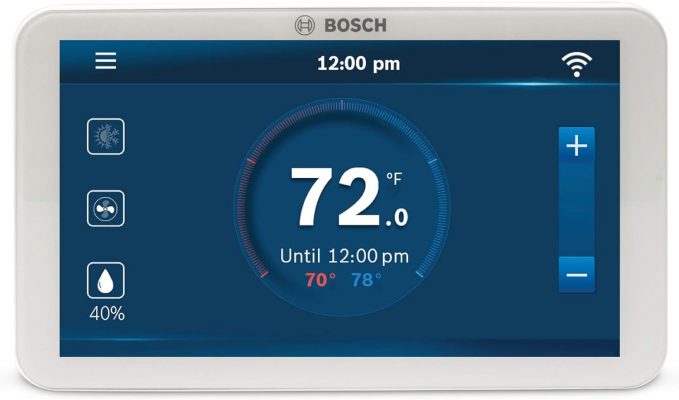
The Bosch BCC100 Connected Control Smart Phone Wi-Fi Thermostat is a solid middle-ground choice in the smart thermostat market. Its standout feature is the large, full-color touchscreen, which not only makes it easier for users to interact with the device but also adds a modern touch to any room’s décor. The interface is intuitive, making it accessible for users of all tech levels, and the physical buttons provide a tactile option for those who may not prefer a touchscreen.
This thermostat’s broad compatibility with various types of HVAC systems adds to its appeal, as it can be a viable option for almost any home. This feature, combined with its ability to be controlled remotely via a smartphone app, offers significant convenience, allowing users to adjust their home’s climate settings from virtually anywhere.
Another notable advantage of the Bosch BCC100 is its programmability. Users can set detailed heating and cooling schedules tailored to their daily routines, which helps in managing energy consumption more effectively. By programming the thermostat to match your lifestyle, you can ensure that you’re not heating or cooling an empty home, which can lead to considerable energy savings over time.
However, the BCC100 does fall short in some areas when compared to higher-end smart thermostats. It does not feature the advanced learning capabilities found in models like the Nest or Ecobee, which can automatically adjust their programming based on real-time data and user habits. Additionally, the absence of remote sensors means it cannot adjust the temperature based on occupancy in different rooms, potentially leading to uneven heating or cooling in larger or multi-story homes.
Despite these limitations, the Bosch BCC100 remains a strong competitor in its price range, offering robust programmability and ease of use. It’s particularly suitable for those who prefer a more hands-on approach to their home climate control and are looking for a straightforward, reliable smart thermostat at an affordable price. This device is ideal for homeowners who want the benefits of smart heating and cooling control without the complexity and higher costs of the most advanced models on the market.
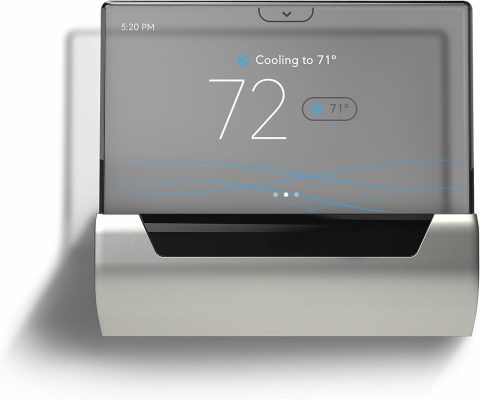
The Johnson Controls GLAS Smart Thermostat stands out primarily due to its unique transparent OLED display, which not only functions as a control panel but also as a piece of modern art. This stylish design can be a major draw for homeowners who value technology that enhances the aesthetic of their space as much as its functionality.
Beyond its appearance, the GLAS thermostat offers sophisticated monitoring of indoor air quality. This feature is particularly valuable for those concerned with health, as it tracks pollutants and humidity levels, providing actionable insights to maintain or improve the environment inside your home. The ability to monitor VOCs and CO2 levels is relatively rare in smart thermostats, setting the GLAS apart in terms of health-oriented features.
Voice control via Microsoft Cortana, Google Assistant, and Amazon Alexa adds a layer of convenience, allowing for easy adjustments and integration with other smart home devices. However, it’s worth noting that while it offers multiple voice assistant options, the functionality with Cortana is somewhat limited compared to its competitors, which may affect users who are deeply integrated into the Microsoft ecosystem.
The GLAS also excels in providing detailed energy usage reports, which not only help in reducing energy costs but also contribute to a more environmentally friendly home. These reports are intuitive and user-friendly, making it easy for homeowners to make informed decisions about their energy usage.
Despite its advanced features and sleek design, the high cost of the GLAS thermostat may be a barrier for some. The investment, however, can be justified by its dual functionality as both a smart home device and an indoor air quality monitor, appealing to those who prioritize health and style equally.
In conclusion, the Johnson Controls GLAS Smart Thermostat is a premium option that offers distinctive design and advanced environmental monitoring capabilities. It is ideal for users who are looking for more than temperature control in a smart thermostat—those who value health insights, energy efficiency, and a device that enhances the decor of their home.
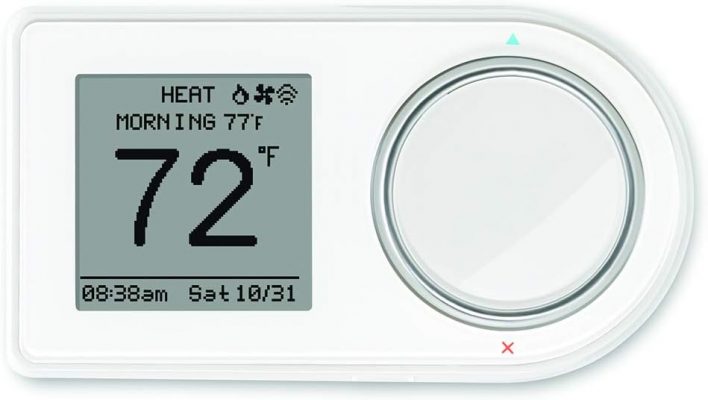
The Lux Geo Wi-Fi Thermostat offers a practical and economical solution for homeowners looking to step into the world of smart home climate control without making a substantial financial commitment. Its standout feature, geo-fencing, is particularly effective for managing heating and cooling based on whether you are at home or away. This technology helps in reducing unnecessary energy usage by automatically adjusting the thermostat settings when you leave the house and resetting them when you approach home, ensuring you always return to a comfortably heated or cooled environment.
The flexible power options are another significant advantage, providing users with the ability to install the thermostat in various settings without worrying about existing wiring or the availability of a C-wire. This makes the Lux Geo particularly appealing to renters or individuals in older homes where wiring for smart home devices might be lacking.
While the Lux Geo covers the basics very well, it does not incorporate the more sophisticated learning technologies seen in premium models. This means that while it can adjust based on location, it does not learn from your temperature preferences or make automatic adjustments based on time of day or weather conditions. Users will need to set schedules and make manual adjustments more frequently compared to those using thermostats like the Nest or Ecobee.
The design of the Lux Geo is functional but does not carry the modern aesthetics that many users might look for in a device that’s visible in their living spaces. However, its simplicity is also a boon for those who prefer a more understated look or are less concerned with the device’s appearance.
In conclusion, the Lux Geo Wi-Fi Thermostat is an excellent choice for those seeking basic smart thermostat functionality without the higher costs associated with more advanced units. It is ideal for users who value straightforward, practical features like geo-fencing and flexible installation options, making it a strong entry-level option in the smart thermostat market.
Installing a smart thermostat can significantly enhance the convenience and efficiency of your home’s heating and cooling systems. Here are some essential tips and troubleshooting advice to ensure a smooth installation and operation.
Once everything is connected, turn the power back on and follow the setup instructions on the thermostat or app to configure your new device.
By following these tips and troubleshooting advice, you can ensure that your smart thermostat installation is successful and that the device functions optimally to enhance your home’s comfort and efficiency. If you encounter issues beyond basic troubleshooting, consult a professional technician or contact the thermostat manufacturer’s customer support for further assistance.
Smart thermostats offer several advantages, including increased energy efficiency, lower heating and cooling costs, remote control via smartphone apps, and the ability to learn your temperature preferences to automatically adjust settings for optimal comfort and efficiency.
Most smart thermostats are designed to be compatible with common HVAC systems, including those that use electricity, gas, or oil. However, it’s important to check the specific compatibility with your system, as some thermostats may require additional components like a C-wire for installation.
While many smart thermostats are designed for DIY installation with detailed instructions and online support, hiring a professional can ensure the device is installed correctly, especially if your home’s wiring is complex or lacks a C-wire. If unsure, it’s best to consult with a professional.
Yes, smart thermostats can significantly reduce your energy bills by learning your schedule and adjusting temperatures accordingly, ensuring that you’re not heating or cooling your home when it’s not necessary. Most users see a return on their investment within a year or two.
Smart thermostats can integrate with various home automation systems via Wi-Fi or home automation protocols like Z-Wave or Zigbee. This integration allows you to control other devices, such as lights and security systems, through the same app or voice commands using assistants like Alexa or Google Assistant.
First, consult the troubleshooting tips provided by the manufacturer, often found in the user manual or online. If the problem persists, consider resetting the thermostat to factory settings or contact customer support for assistance. For connectivity issues, checking your home’s Wi-Fi network can also be beneficial.
Most smart thermostats do not have ongoing costs, but some features, like advanced data analysis or multi-home management, may require a subscription. Additionally, firmware updates and app improvements are typically provided for free.
Yes, one of the key features of smart thermostats is the ability to control them remotely via a smartphone app. This feature is particularly useful for adjusting your home’s temperature before you arrive or ensuring everything is turned off when you’re away.
Smart thermostats use various security measures to protect against unauthorized access, including data encryption and secure cloud services. However, like any connected device, it is important to use strong, unique passwords and keep your home network secure.
Yes, smart thermostats can be installed in apartments, but it’s important to check with your landlord or management company before installation to ensure compliance with building policies. Additionally, consider the compatibility with the apartment’s HVAC system and whether modifications like a C-wire are feasible.
As we wrap up our comprehensive guide on smart thermostats here at Nakomart.com, it’s clear that these devices are not just gadgets; they are transformative tools for enhancing the way we live. They merge convenience, energy efficiency, and cost-effectiveness into one smart package, revolutionizing home climate control.
From the sleek Nest Learning Thermostat to the innovative Johnson Controls GLAS, the market offers a range of models designed to suit different preferences and needs. Consider your specific lifestyle, your home’s HVAC compatibility, and desired features when selecting your smart thermostat. Installation can be a simple DIY project for many models; however, professional assistance is always a smart choice if you encounter complex system requirements.
The future holds exciting developments for smart thermostats, with advancements in AI, machine learning, and integration capabilities on the horizon. These innovations promise even greater control and customization of home environments, pushing the boundaries of what smart home devices can achieve.
Thank you for turning to Nakomart.com for insights into the dynamic world of smart thermostats. Whether you’re upgrading your home or taking your first steps into smart technology, a smart thermostat offers a gateway to a more efficient, comfortable, and controlled home environment. Continue to follow us for in-depth reviews and updates on the latest in smart home technology. Make the smart choice today and transform your home into a more sustainable, comfortable, and intelligent living space.
Affiliate Disclosure: Nakomart.com sometimes gets paid for listings, through sponsors or affiliate programs like Amazon Associates. Clicking a link helps keep Nakomart.com free, at no extra cost to you!
Nakomart.com is a participant in the Amazon Services LLC Associates Program, an affiliate advertising program designed to provide a means for sites to earn advertising fees by advertising and linking to Amazon.com.
Amazon and the Amazon logo are trademarks of Amazon.com, Inc. or one of its affiliates.
Necessary cookies are absolutely essential for the website to function properly. These cookies ensure basic functionalities and security features of the website, anonymously.
| Cookie | Duration | Description |
|---|---|---|
| cookielawinfo-checbox-analytics | 11 months | This cookie is set by GDPR Cookie Consent plugin. The cookie is used to store the user consent for the cookies in the category "Analytics". |
| cookielawinfo-checbox-functional | 11 months | The cookie is set by GDPR cookie consent to record the user consent for the cookies in the category "Functional". |
| cookielawinfo-checbox-others | 11 months | This cookie is set by GDPR Cookie Consent plugin. The cookie is used to store the user consent for the cookies in the category "Other. |
| cookielawinfo-checkbox-necessary | 11 months | This cookie is set by GDPR Cookie Consent plugin. The cookies is used to store the user consent for the cookies in the category "Necessary". |
| cookielawinfo-checkbox-performance | 11 months | This cookie is set by GDPR Cookie Consent plugin. The cookie is used to store the user consent for the cookies in the category "Performance". |
| viewed_cookie_policy | 11 months | The cookie is set by the GDPR Cookie Consent plugin and is used to store whether or not user has consented to the use of cookies. It does not store any personal data. |
Functional cookies help to perform certain functionalities like sharing the content of the website on social media platforms, collect feedbacks, and other third-party features.
Performance cookies are used to understand and analyze the key performance indexes of the website which helps in delivering a better user experience for the visitors.
Analytical cookies are used to understand how visitors interact with the website. These cookies help provide information on metrics the number of visitors, bounce rate, traffic source, etc.
Advertisement cookies are used to provide visitors with relevant ads and marketing campaigns. These cookies track visitors across websites and collect information to provide customized ads.
Other uncategorized cookies are those that are being analyzed and have not been classified into a category as yet.